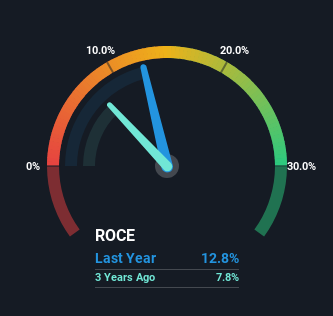Toyo Shutter (TSE:5936) Will Be Hoping To Turn Its Returns On Capital Around

When we're researching a company, it's sometimes hard to find the warning signs, but there are some financial metrics that can help spot trouble early. A business that's potentially in decline often shows two trends, a return on capital employed (ROCE) that's declining, and a base of capital employed that's also declining. This indicates to us that the business is not only shrinking the size of its net assets, but its returns are falling as well. On that note, looking into Toyo Shutter (TSE:5936), we weren't too upbeat about how things were going.
What Is Return On Capital Employed (ROCE)?
Just to clarify if you're unsure, ROCE is a metric for evaluating how much pre-tax income (in percentage terms) a company earns on the capital invested in its business. The formula for this calculation on Toyo Shutter is:
Return on Capital Employed = Earnings Before Interest and Tax (EBIT) ÷ (Total Assets - Current Liabilities)
0.13 = JP¥1.3b ÷ (JP¥20b - JP¥9.9b) (Based on the trailing twelve months to June 2024).
So, Toyo Shutter has an ROCE of 13%. On its own, that's a standard return, however it's much better than the 7.3% generated by the Building industry.
View our latest analysis for Toyo Shutter

Historical performance is a great place to start when researching a stock so above you can see the gauge for Toyo Shutter's ROCE against it's prior returns. If you'd like to look at how Toyo Shutter has performed in the past in other metrics, you can view this free graph of Toyo Shutter's past earnings, revenue and cash flow.
What Does the ROCE Trend For Toyo Shutter Tell Us?
In terms of Toyo Shutter's historical ROCE movements, the trend doesn't inspire confidence. Unfortunately the returns on capital have diminished from the 16% that they were earning five years ago. Meanwhile, capital employed in the business has stayed roughly the flat over the period. Since returns are falling and the business has the same amount of assets employed, this can suggest it's a mature business that hasn't had much growth in the last five years. If these trends continue, we wouldn't expect Toyo Shutter to turn into a multi-bagger.
Another thing to note, Toyo Shutter has a high ratio of current liabilities to total assets of 50%. This effectively means that suppliers (or short-term creditors) are funding a large portion of the business, so just be aware that this can introduce some elements of risk. Ideally we'd like to see this reduce as that would mean fewer obligations bearing risks.
In Conclusion...
All in all, the lower returns from the same amount of capital employed aren't exactly signs of a compounding machine. But investors must be expecting an improvement of sorts because over the last five yearsthe stock has delivered a respectable 50% return. Regardless, we don't feel too comfortable with the fundamentals so we'd be steering clear of this stock for now.
One more thing, we've spotted 3 warning signs facing Toyo Shutter that you might find interesting.
While Toyo Shutter isn't earning the highest return, check out this free list of companies that are earning high returns on equity with solid balance sheets.
If you're looking to trade Toyo Shutter, open an account with the lowest-cost platform trusted by professionals, Interactive Brokers.
With clients in over 200 countries and territories, and access to 160 markets, IBKR lets you trade stocks, options, futures, forex, bonds and funds from a single integrated account.
Enjoy no hidden fees, no account minimums, and FX conversion rates as low as 0.03%, far better than what most brokers offer.
Sponsored ContentValuation is complex, but we're here to simplify it.
Discover if Toyo Shutter might be undervalued or overvalued with our detailed analysis, featuring fair value estimates, potential risks, dividends, insider trades, and its financial condition.
Access Free AnalysisHave feedback on this article? Concerned about the content? Get in touch with us directly. Alternatively, email editorial-team (at) simplywallst.com.
This article by Simply Wall St is general in nature. We provide commentary based on historical data and analyst forecasts only using an unbiased methodology and our articles are not intended to be financial advice. It does not constitute a recommendation to buy or sell any stock, and does not take account of your objectives, or your financial situation. We aim to bring you long-term focused analysis driven by fundamental data. Note that our analysis may not factor in the latest price-sensitive company announcements or qualitative material. Simply Wall St has no position in any stocks mentioned.
Have feedback on this article? Concerned about the content? Get in touch with us directly. Alternatively, email editorial-team@simplywallst.com
About TSE:5936
Toyo Shutter
Manufactures, installs, purchases, imports, sells, and exports various shutters, doors, hardware, and building fixtures, materials, and consumables in Japan.
Excellent balance sheet average dividend payer.
Market Insights
Community Narratives




